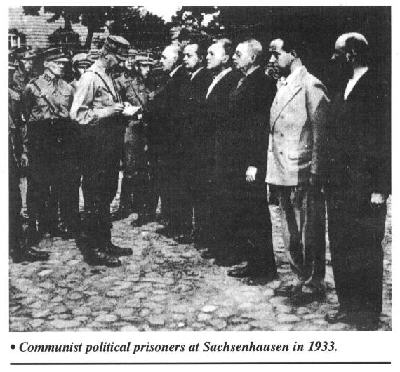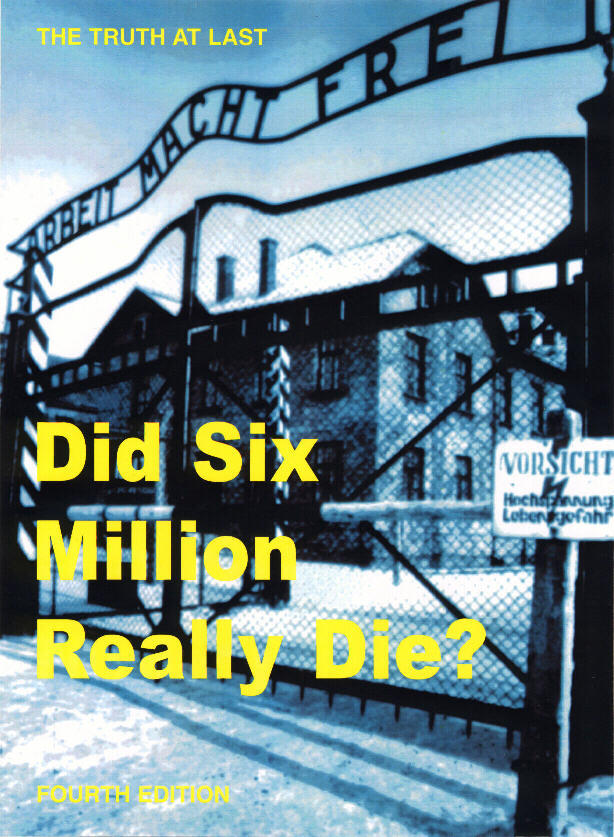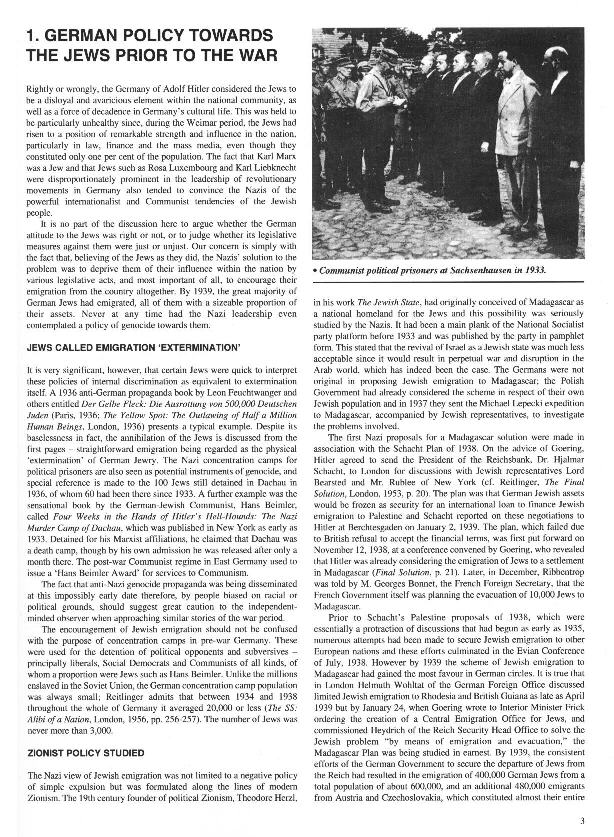Did Six Million Really Die?[ DSM ]Latest 2015 printing with reference amendments and a new back cover.This publication is now banned by eBay, Amazon and Paypal. |
||

|
‘The wise man wants to hear both sides of every question’
You may have heard of so-called Revisionists who “deny the Holocaust.” This publication, a revisionist best-seller, is an authoritative and detailed account of the facts behind the fiction. It details the Nazi plan for a Jewish homeland in Madagascar (blocked by the British); the Jewish declaration of war against Germany; the Wannsee Conference; the Einsatzgruppen; the Warsaw Ghetto; the chaotic state of the Concentration Camp system at the end of the war; fake photographs; and the “Final Solution.” This hard to find, extensively referenced publication is an essential addition to the library of anyone with an interest in WWII history. Magazine format, 28 pages, illustrated with photographs. Published in Britain by the Historical Review Press (ISBN 978-0-906879-95-5) and available from the Heretical Press price £6.00 inclusive. |
|
| PDF download | A4 paper size. Use US Legal (110%?) or scale to 90% for US Letter. | |
|
||
- German Policy Towards the Jews Prior to the War
- German Policy Towards the Jews After the Outbreak of War
- Population and Emigration
- The Six Million: Documentary Evidence
- The Nuremberg Trials
- Auschwitz and Polish Jewry
- Some Concentration Camp Memoirs
- The Nature and Condition of War-Time Concentration Camps
- The Jews and the Concentration Camps: A Factual Appraisal by the Red Cross
- The Truth at Last: The Work of Paul Rassinier
Conclusion
Introduction to the 4th Edition

From Section One, German Policy Towards the Jews Prior to the War
Rightly or wrongly, the Germany of Adolf Hitler considered the Jews to be a disloyal and avaricious element within the national community, as well as a force of decadence in Germany’s cultural life. This was held to be particularly unhealthy since, during the Weimar period, the Jews had risen to a position of remarkable strength and influence in the nation, particularly in law, finance and the mass media, even though they constituted only one per cent of the population. The fact that Karl Marx was a Jew and that Jews such as Rosa Luxembourg and Karl Liebknecht were disproportionately prominent in the leadership of revolutionary movements in Germany also tended to convince the Nazis of the powerful internationalist and Communist tendencies of the Jewish people.
It is no part of the discussion here to argue whether the German attitude to the Jews was right or not, or to judge whether its legislative measures against them were just or unjust. Our concern is simply with the fact that, believing of the Jews as they did, the Nazis’ solution to the problem was to deprive them of their influence within the nation by various legislative acts, and most important of all, to encourage their emigration from the country altogether. By 1939, the great majority of German Jews had emigrated, all of them with a sizeable proportion of their assets. Never at any time had the Nazi leadership even contemplated a policy of genocide towards them.
JEWS CALLED EMIGRATION ‘EXTERMINATION’
It is very significant, however, that certain Jews were quick to interpret these policies of internal discrimination as equivalent to extermination itself. A 1936 anti-German propaganda book by Leon Feuchtwanger and others entitled Der Gelbe Fleck: Die Ausrottung von 500,000 Deutschen Juden (Paris, 1936; The Yellow Spot: The Outlawing of Half a Million Human Beings, London, 1936) presents a typical example. Despite its baselessness in fact, the annihilation of the Jews is discussed from the first pages – straightforward emigration being regarded as the physical ‘extermination’ of German Jewry. The Nazi concentration camps for political prisoners are also seen as potential instruments of genocide, and special reference is made to the 100 Jews still detained in Dachau in 1936, of whom 60 had been there since 1933. A further example was the sensational book by the German-Jewish Communist, Hans Beimler, called Four Weeks in the Hands of Hitler’s Hell-Hounds: The Nazi Murder Camp of Dachau, which was published in New York as early as 1933. Detained for his Marxist affiliations, he claimed that Dachau was a death camp, though by his own admission he was released after only a month there. The post-war Communist regime in East Germany used to issue a ‘Hans Beimler Award’ for services to Communism.
The fact that anti-Nazi genocide propaganda was being disseminated at this impossibly early date therefore, by people biased on racial or political grounds, should suggest great caution to the independent-minded observer when approaching similar stories of the war period.
The encouragement of Jewish emigration should not be confused with the purpose of concentration camps in pre-war Germany. These were used for the detention of political opponents and subversives – principally liberals, Social Democrats and Communists of all kinds, of whom a proportion were Jews such as Hans Beimler. Unlike the millions enslaved in the Soviet Union, the German concentration camp population was always small; Reitlinger admits that between 1934 and 1938 throughout the whole of Germany it averaged 20,000 or less (The SS: Alibi of a Nation, London, 1956, pp. 256-257). The number of Jews was never more than 3,000.



